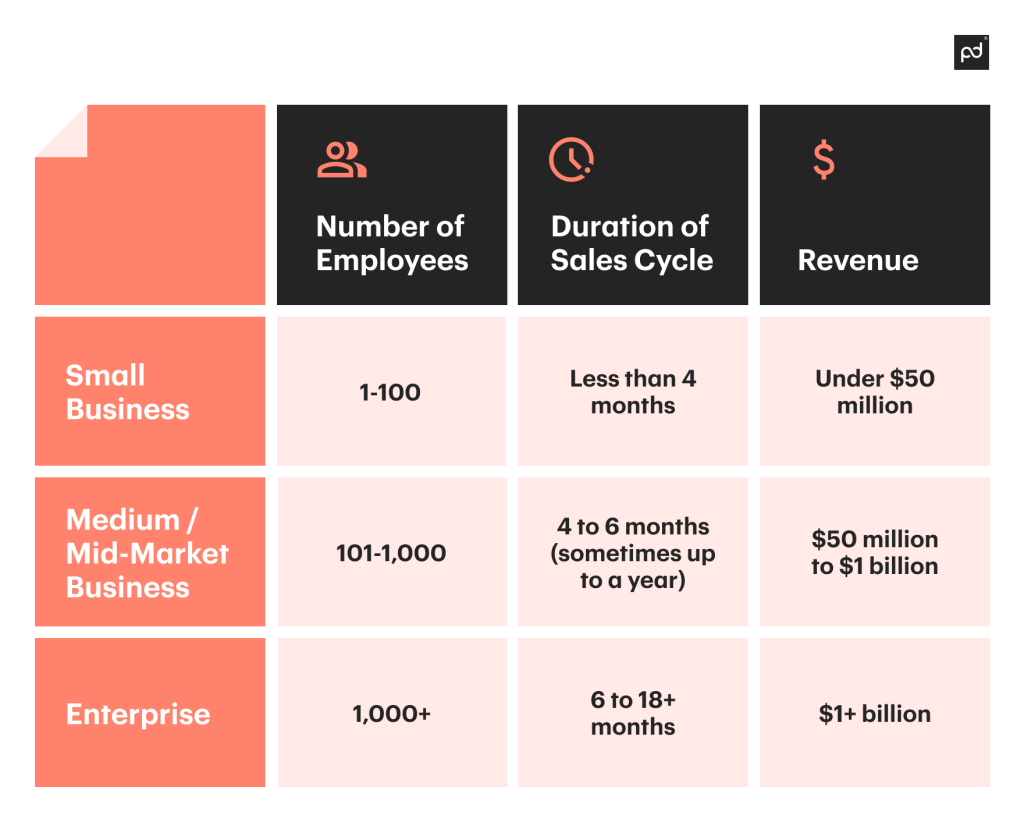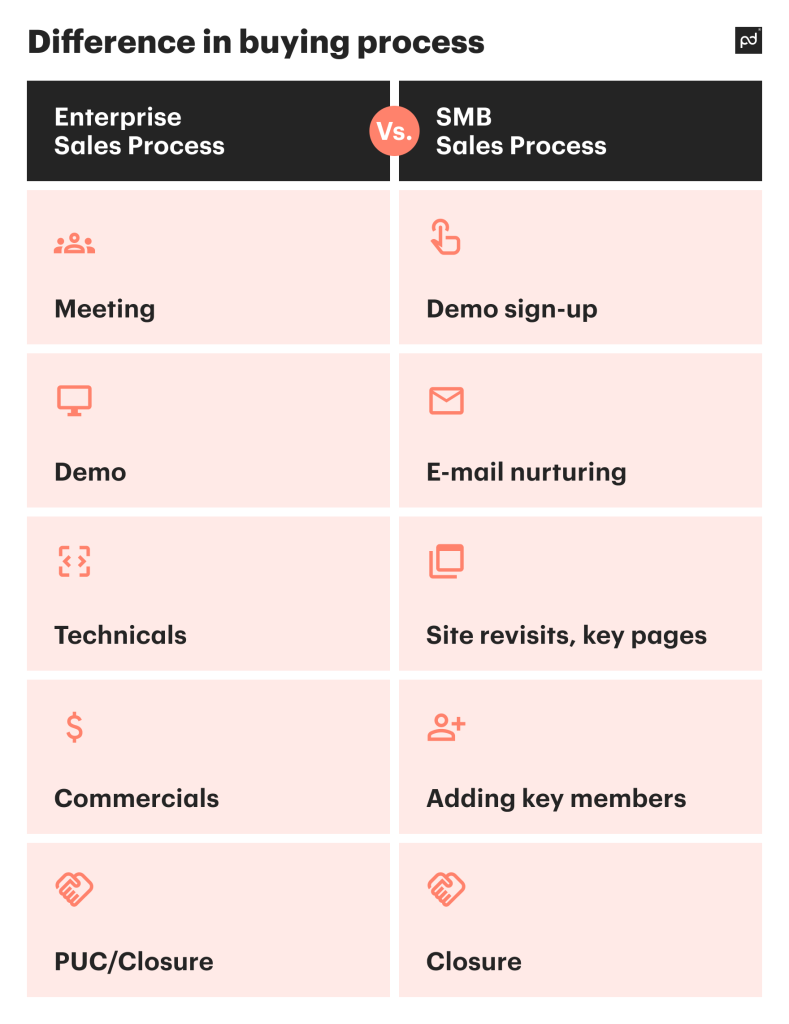Thousands of small and midsize businesses (SMBs) are joining the market every week.
In the U.S. alone there are about 33.2 million small businesses, which constitutes up to 99.9% of all the businesses across the country.
Such huge numbers equate to huge revenue potential in terms of SMB sales.
Which approach and tools should you implement to make the most of this potential?
Read on as we cover everything you need to know about the SMB sales process, and how your sales team can crush it in the competitive landscape.
Key takeaways
- With its specific business needs, budget restrictions, and customization requirements, the sales landscape for small- and medium-sized businesses requires a different strategy than enterprise and B2C sales.
- Successful implementation of a tailored SMB sales approach results in long-term benefits like ongoing relationships and increased lead generation.
- A robust SMB sales strategy is underpinned by adopting smart solutions like document management software and sales automation tools.
What are SMB sales?
Small businesses are companies with fewer than 100 employees.
By medium-sized businesses, we mean firms in the 100-999 employee range.
As per revenue, the first type usually generates under $50 million annually, and the second one — between $50 million and $1 billion.

What is the difference between SMB vs B2C?
Selling to small and medium businesses is different from B2C deals, where people are ready to make a purchase without extra persuading.
Business owners, conversely, are quite busy and possibly impatient, so your offer should quickly engage them by demonstrating your value proposition through demos and other sales material.
Be ready to explain all complex technical concepts in simple, provide clear answers, as well as address concerns around solution cost, implementation, and support.
Tailor your strategy and offerings to a company’s specific processes and pain points by considering the following aspects:
- They usually have limited IT budgets, which makes decision-makers quite careful about spendings
- They conduct research by themselves before contacting vendors
- They understand the consequences of choosing the wrong solution, so they tend not to choose at all
- They have just one or a small group of decision-makers
SMB and SaaS
Aiming to digitize their workflows, SMBs continue adopting software as a service (SaaS) solutions.
In 2026, SaaS spending by SMBs is projected to reach $291 billion, constituting 63% of total global spendings. SMBs favor SaaS for a number of reasons:
- Flexibility in terms of adding and removing licenses as business requirements change
- Easy immediate access to a wide range of tools when needed
- Timely software updates without the burden of administration
- Cost savings, as SMBs are spared the need to create and maintain their own IT infrastructure
- Rock-solid security in terms of data, applications, and services — through best practices and standard compliance
The understanding of these and other key aspects will give you a significant level-up in building a winning sales strategy.
Key benefits of SMB sales
Although SMB sales require considerable effort and a highly tailored approach, in the long run, you’ll get more bang for your buck. Here are some of the clear advantages.
Short sales cycle
As opposed to enterprise deals, the SMB sales process is much simpler and doesn’t require large budgets.
Less complexity translates to less time and effort spent to reach a prospect — an opportunity your team can leverage.

Enterprise sales cycle can also be enlarged due to objections brought by multiple stakeholders.
Small companies, alternatively, are usually governed by only one decision-maker, so the process of addressing objections is less challenging.
Enhanced lead generation
With so many SMBs on the worldwide arena, sales representatives have an enormous pool for converting leads.
And a solid word-of-mouth culture of SMBs drives a great referral network, which notably increases lead generation.
Close ongoing relationships
Considering the intimate nature of SMB deals, your sales managers have all the chances to create close, faithful relationships.
This is particularly important, because putting the time in now will convert into a long-term ROI, meaning sustainable profit and increased business scalability.
Challenges of selling to SMBs
In any business strategy there’s the other side of the coin, and the SMB sales process is no exception.
Budget restrictions
SMBs usually have small IT budgets, about $10,000-$49,000 spent annually.
Before choosing any technology for implementation, they thoroughly investigate the vendor.
With this in mind, be ready to prepare a solid business offer.
Provide your risk-averse clients with the possibility to deploy the right solution on the fly to solve their specific, well-understood problems.
Need for customization
SMBs usually don’t have resources allocated for complex customization and first-class packages, so be ready for financial objections.
Take this into account not only when discussing the potential scope of work, but also when composing the initial IT budget.
Steps to create your winning SMB sales strategy
Everyone in sales spends a part of the day thinking about targets they want to hit, and goals they’re looking to crush.
Let’s continue with specific actions SMB sales managers should take to do just that.
Investigate
If you’ve already had the opportunity to partner with small- and medium-sized businesses, make the most of these connections!
Use customized form builders to find out what worked best for SMBs, what pain points your product managed to solve and what challenges were left unaddressed.
And always be curious when asking about the triggers that led to closing the deal.
Build ICP
Empowered by rich insights from customer surveys, proceed to building out an ideal customer profile (ICP).
Make this process more efficient and transparent through marketing automation software, automatically create related docs, where marketing and sales teams will collaborate in real time.
Map customer journeys
With a clear understanding of who your customers are and what they want, start mapping a customer journey — possible interactions between you and your potential clients.
User behaviors can be reinforced with customer analytics, i.e., in-depth data on real customers’ actions. The information you need for an analysis can be gathered through automated tools like our New Customer Registration Form template.
Create prospects
Sales reps often claim that prospecting is the most challenging part of the sales process.
To convert potential customers into real ones you should prepare eye-catching business proposals.
Automated solutions will not only help create professional personalized proposals, but will also enable smooth collaboration inside the proposal and automatic follow-up reminders.
Start lead generation
To help convert prospects into leads, employ sales automation tools into your workflows whenever possible.
One way to revamp your sales pipeline while catering to the SMB market is with online CPQ software. This solution leverages data from your product catalog and implements rules-based pricing strategies to generate error-free quotes.
Your sales representatives won’t waste time on manually correcting or copying quotes when interacting with small business owners, which will drive faster response times and help cement relationships at the same time.
Close deals
Contract management software eliminates paperwork and reduces the chance of costly mistakes, getting your deals across the finish line that much faster.
PandaDoc solutions enable transparent communication without email chains, resulting in speedy decision-making and improved customer experience.
Draft documents with minimal manual efforts, seamless real-time editing and collaboration, error-free terms standardization, and legally binding eSignatures — all in the service of closing deals quicker, and with greater accuracy.
Evaluate
The metrics for measuring process success should include not only revenue, but also customer acquisition, sales cycle duration, average deal size, and customer satisfaction.
Pulling up-to-date data from an integrated CRM makes evaluating progress via dashboards and running reports a breeze, and all these aspects will help you understand how efficient your team was at every stage of the sales pipeline — and find room for improvement.
Reach more accounts with PandaDoc
Optimizing sales processes for maximum wins is a never-ending task.
And crafting the right strategy for selling to small- and medium-sized businesses comes with its own unique obstacles — challenges made easier with the right tech by your side.
The PandaDoc platform offers sales automation tools alongside a host of solutions that can facilitate every step of your sales pipeline, from customer research and market analysis to business proposal creation and lead generation — all while addressing the specifics of SMBs.
Book a 15-minute demo to learn more about how the right tools translate to more wins for your sales team.
Disclaimer
PandaDoc is not a law firm, or a substitute for an attorney or law firm. This page is not intended to and does not provide legal advice. Should you have legal questions on the validity of e-signatures or digital signatures and the enforceability thereof, please consult with an attorney or law firm. Use of PandaDoc services are governed by our Terms of Use and Privacy Policy.


